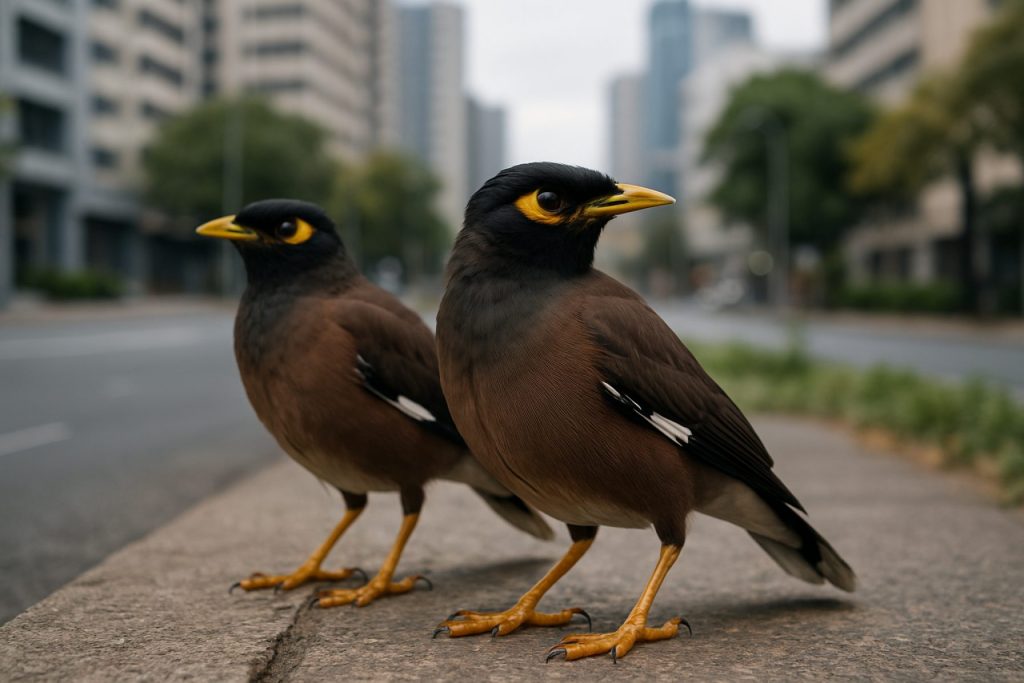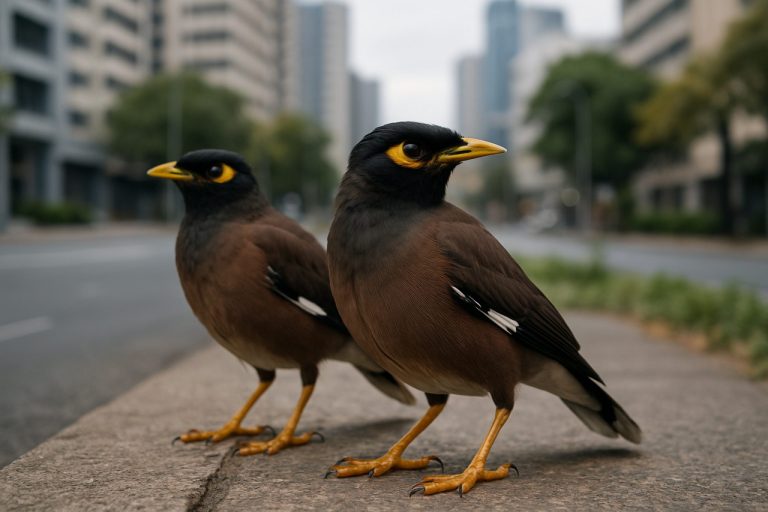
How Mynas Are Transforming Urban Landscapes: Unpacking Their Ecological Impact, Social Dynamics, and the Future of City Biodiversity. Discover why these adaptable birds are at the center of urban wildlife debates. (2025)
- Introduction: Mynas and the Urban Wildlife Revolution
- Species Overview: Key Myna Types in Cities
- Adaptation Strategies: How Mynas Thrive in Urban Environments
- Ecological Impacts: Effects on Native Species and Biodiversity
- Human-Myna Interactions: Benefits, Challenges, and Public Perception
- Technological Tools for Monitoring Urban Mynas
- Management and Control: Policies and Best Practices
- Case Studies: Global Cities and Their Myna Populations
- Market and Public Interest Forecast: Trends and Growth Projections
- Future Outlook: Innovations and the Evolving Role of Mynas in Urban Ecosystems
- Sources & References
Introduction: Mynas and the Urban Wildlife Revolution
The presence of mynas in urban ecosystems has become emblematic of the broader “urban wildlife revolution” currently underway in cities worldwide. Mynas, particularly the Common Myna (Acridotheres tristis) and the Crested Myna (Acridotheres cristatellus), are among the most successful avian colonizers of metropolitan environments. Their adaptability, intelligence, and opportunistic feeding behaviors have enabled them to thrive in densely populated human settlements, often outcompeting native bird species and altering local biodiversity dynamics.
As of 2025, mynas are established in urban centers across Asia, Australia, the Middle East, and parts of Africa and Europe. Their expansion is closely monitored by environmental authorities due to their classification as invasive species in several regions. For example, the International Union for Conservation of Nature (IUCN) lists the Common Myna among the world’s 100 worst invasive alien species, citing its impact on native fauna and urban ecological balance. The Australian Government Department of Climate Change, Energy, the Environment and Water has also highlighted the myna’s role in displacing native birds and competing for nesting sites, prompting ongoing management and research initiatives.
Recent urban ecology studies indicate that mynas exploit a wide range of anthropogenic resources, from food waste to artificial nesting cavities, facilitating their population growth in cities. Data collected by urban biodiversity monitoring programs in 2024 and early 2025 show that myna densities in some metropolitan areas have increased by up to 20% over the past five years, correlating with urban sprawl and changes in waste management practices. This trend is expected to continue, with projections suggesting further range expansion and population growth in cities with suitable climates and infrastructure.
Looking ahead, the outlook for mynas in urban ecosystems is shaped by both their biological advantages and the evolving strategies of urban wildlife management. Authorities and conservation organizations are intensifying efforts to mitigate the ecological impacts of mynas, including public awareness campaigns, habitat restoration for native species, and targeted control measures. The next few years will likely see increased collaboration between city planners, ecologists, and governmental agencies to balance urban development with biodiversity conservation, as the myna’s success story continues to challenge traditional notions of urban wildlife and ecosystem resilience.
Species Overview: Key Myna Types in Cities
Mynas, belonging to the starling family (Sturnidae), are among the most conspicuous avian residents of urban environments across Asia, Australia, Africa, and parts of Europe. Their adaptability, vocal prowess, and opportunistic feeding have enabled several species to thrive in cities, often outcompeting native birds. As of 2025, the most prominent myna species in urban ecosystems include the Common Myna (Acridotheres tristis), the Jungle Myna (Acridotheres fuscus), and the Crested Myna (Acridotheres cristatellus), each with distinct ecological impacts and distribution patterns.
- Common Myna (Acridotheres tristis): Native to South Asia, the Common Myna has become one of the world’s most successful urban birds. Its introduction to cities in Australia, the Middle East, and Africa has led to rapid population growth, with recent urban surveys in 2024–2025 reporting densities exceeding 100 individuals per square kilometer in some metropolitan areas. The species is listed among the world’s 100 worst invasive species by the International Union for Conservation of Nature due to its aggressive competition with native birds for nesting sites and food.
- Jungle Myna (Acridotheres fuscus): Slightly less urbanized than the Common Myna, the Jungle Myna is increasingly observed in peri-urban and suburban zones, particularly in South and Southeast Asia. Recent data from 2023–2025 indicate a gradual shift towards city centers, likely driven by habitat modification and food availability. The BirdLife International network has noted expanding urban records in India and Bangladesh, with potential for further spread.
- Crested Myna (Acridotheres cristatellus): Originally native to China and Southeast Asia, the Crested Myna has established urban populations in cities such as Vancouver, Canada, and Hong Kong. While its global range is more restricted, ongoing monitoring by local ornithological societies in 2024–2025 suggests stable or slightly increasing numbers in select urban centers, with concerns about hybridization and competition with native starlings.
Looking ahead, urban expansion and climate change are expected to further facilitate the spread of mynas into new metropolitan areas. Conservation authorities, including the International Union for Conservation of Nature and BirdLife International, are prioritizing research on myna population dynamics, urban adaptation, and mitigation strategies to balance their ecological impacts with urban biodiversity goals. The next few years will likely see increased monitoring and management efforts, particularly in cities where mynas threaten native avifauna and urban ecosystem health.
Adaptation Strategies: How Mynas Thrive in Urban Environments
Mynas, particularly the Common Myna (Acridotheres tristis) and the Crested Myna (Acridotheres cristatellus), have demonstrated remarkable adaptability to urban environments, a trend that is expected to persist and intensify through 2025 and the coming years. Their success in cities is attributed to a suite of behavioral, ecological, and physiological strategies that allow them to exploit anthropogenic resources and navigate the challenges of urban living.
One of the primary adaptation strategies of mynas is their omnivorous and opportunistic feeding behavior. Mynas readily consume a wide variety of food sources, including insects, fruits, human food waste, and even small vertebrates. This dietary flexibility enables them to thrive in diverse urban landscapes, from residential neighborhoods to commercial districts. Recent urban ecology studies have documented that mynas are increasingly utilizing food scraps from outdoor dining areas and waste bins, a trend likely to continue as urbanization expands and human populations grow (BirdLife International).
Mynas also exhibit advanced nesting adaptability. They are cavity nesters, often exploiting artificial structures such as building crevices, streetlights, and signboards for nesting sites. This ability to use man-made structures reduces their dependence on natural tree cavities, which are often scarce in urban settings. Ongoing monitoring by ornithological organizations indicates that mynas are expanding their breeding territories within cities, with some populations showing year-round breeding cycles due to the stable microclimates and constant food availability in urban areas (International Union for Conservation of Nature).
Social behavior is another key adaptation. Mynas are highly gregarious, forming large communal roosts that provide safety from predators and facilitate information sharing about food sources. These communal roosts, often located in urban parks or on utility infrastructure, can number in the thousands and are expected to become more prominent as urban green spaces are developed or restored in line with city planning initiatives.
Looking ahead, the outlook for mynas in urban ecosystems remains robust. Their population densities in cities are projected to increase, especially in rapidly urbanizing regions of Asia, Africa, and Australia. However, their success also raises concerns about competition with native bird species and potential impacts on urban biodiversity. Conservation authorities and urban planners are increasingly considering management strategies to balance the ecological roles of mynas with the preservation of native avifauna (Australian Government Department of Climate Change, Energy, the Environment and Water).
Ecological Impacts: Effects on Native Species and Biodiversity
The ecological impacts of mynas, particularly the Common Myna (Acridotheres tristis), in urban ecosystems have become increasingly pronounced as their populations continue to expand in cities worldwide. As of 2025, mynas are recognized as one of the world’s most invasive bird species, with established populations across Asia, Australia, the Middle East, and parts of Africa and the Pacific. Their adaptability to urban environments, aggressive behavior, and generalist diet have significant consequences for native species and urban biodiversity.
Mynas compete directly with native birds for nesting sites, food resources, and territory. Studies in Australia and New Zealand have documented declines in native cavity-nesting birds, such as parrots and some small passerines, in areas where mynas have become established. The Australian Government Department of Climate Change, Energy, the Environment and Water has identified the Common Myna as a key threat to native biodiversity, noting its ability to displace native birds from nesting hollows and outcompete them for food. This displacement is particularly acute in urban settings, where natural nesting sites are already limited due to habitat fragmentation and human development.
Recent urban biodiversity surveys indicate that mynas can reduce the abundance and diversity of native bird species in city parks and gardens. For example, research supported by the Commonwealth Scientific and Industrial Research Organisation (CSIRO) has shown that areas with high myna densities exhibit lower numbers of native insectivorous and frugivorous birds. This shift in avian community structure can have cascading effects on ecosystem functions, such as pollination and insect population control, potentially altering the ecological balance of urban green spaces.
Mynas also impact other urban wildlife. Their aggressive nest defense and predation on eggs and chicks can affect small mammals and reptiles. Furthermore, their role as potential vectors for avian diseases raises concerns for both native wildlife and urban poultry.
Looking ahead to the next few years, urban planners and conservation agencies are intensifying efforts to monitor and manage myna populations. The International Union for Conservation of Nature (IUCN) continues to list the Common Myna among the world’s 100 worst invasive alien species, emphasizing the need for coordinated management strategies. These include public awareness campaigns, nest box modifications to favor native species, and targeted removal programs. The effectiveness of such interventions will be critical in determining the future trajectory of urban biodiversity in cities where mynas are present.
Human-Myna Interactions: Benefits, Challenges, and Public Perception
Mynas, particularly the Common Myna (Acridotheres tristis) and the Crested Myna (Acridotheres cristatellus), have become prominent members of urban ecosystems across Asia, Australia, the Middle East, and parts of Europe. Their adaptability to human-modified environments has led to complex interactions with urban populations, presenting both benefits and challenges as cities continue to expand in 2025 and beyond.
One of the primary benefits of mynas in urban areas is their role in controlling insect populations. Mynas are opportunistic feeders, consuming a wide range of insects, including agricultural pests. This natural pest control can reduce the need for chemical pesticides in city gardens and parks, contributing to more sustainable urban green spaces. Additionally, their presence adds to urban biodiversity, providing opportunities for urban dwellers to engage with wildlife and fostering environmental awareness, especially among children and birdwatchers.
However, the challenges associated with mynas are significant and increasingly recognized by city planners and environmental authorities. Mynas are highly competitive, often displacing native bird species through aggressive behavior and competition for nesting sites. In Australia, for example, the Common Myna is listed among the world’s 100 worst invasive species, with documented negative impacts on native birds and small mammals. Their adaptability allows them to thrive in disturbed habitats, leading to concerns about biodiversity loss in urban settings (Australian Government Department of Climate Change, Energy, the Environment and Water).
Mynas are also known for their association with human waste, as they frequently scavenge in garbage bins and landfills. This behavior can contribute to the spread of pathogens and exacerbate urban hygiene issues. Noise pollution is another concern, as large communal roosts can create significant disturbances in residential areas, leading to complaints and calls for management interventions.
Public perception of mynas is mixed and varies by region. In some cultures, mynas are valued for their intelligence and mimicry, even kept as pets. In others, they are viewed as pests or invasive threats. Recent surveys in cities like Sydney and Singapore indicate growing public support for management programs aimed at controlling myna populations, including nest removal and exclusion from key habitats. Municipalities are increasingly collaborating with conservation organizations to develop humane and effective strategies for mitigating myna impacts while preserving urban biodiversity (National Parks Board Singapore).
Looking ahead, the outlook for human-myna interactions in urban ecosystems will depend on the effectiveness of integrated management approaches, public education, and ongoing research into their ecological roles. As urbanization intensifies, balancing the benefits and challenges posed by mynas will remain a priority for city planners and environmental authorities worldwide.
Technological Tools for Monitoring Urban Mynas
The monitoring of mynas (Acridotheres spp.) in urban ecosystems is increasingly reliant on advanced technological tools, reflecting both the growing concern over their ecological impact and the opportunities presented by digital innovation. As of 2025, urban wildlife researchers and city authorities are leveraging a suite of technologies to track, analyze, and manage myna populations, with a focus on both invasive species such as the common myna (Acridotheres tristis) and native urban-adapted species.
One of the most significant developments is the integration of automated acoustic monitoring systems. These devices, equipped with sensitive microphones and machine learning algorithms, can distinguish myna calls from other urban bird species, enabling continuous, non-intrusive population surveys. Such systems are being deployed in cities across Australia, India, and Southeast Asia, where mynas are either invasive or of management concern. The use of open-source platforms and cloud-based data storage allows for real-time data sharing and collaborative analysis among researchers and municipal agencies.
Camera traps and networked video surveillance are also being adapted for urban avifauna monitoring. High-resolution cameras, sometimes combined with artificial intelligence (AI) for species recognition, are installed in parks, public squares, and near known roosting sites. These tools provide valuable data on myna behavior, flock sizes, and interactions with other urban wildlife. In Singapore, for example, the National Parks Board has piloted AI-driven video analytics to monitor bird populations, including mynas, as part of its broader urban biodiversity management strategy (National Parks Board).
Citizen science platforms are playing a growing role in data collection. Mobile applications and web portals allow residents to report myna sightings, upload photographs, and contribute to mapping efforts. These participatory tools not only expand the spatial and temporal coverage of monitoring but also foster public engagement in urban biodiversity issues. Organizations such as the BirdLife International network and local ornithological societies are supporting these initiatives by providing identification guides and data validation protocols.
Looking ahead, the next few years are expected to see further integration of Internet of Things (IoT) devices, drone-based aerial surveys, and advanced data analytics in urban myna monitoring. The convergence of these technologies promises more precise, large-scale, and cost-effective management of myna populations, supporting both conservation goals and urban ecosystem health. Continued collaboration between governmental agencies, research institutions, and the public will be crucial to harnessing these tools effectively and ethically.
Management and Control: Policies and Best Practices
The management and control of mynas, particularly the Common Myna (Acridotheres tristis) and the Crested Myna (Acridotheres cristatellus), have become increasingly important in urban ecosystems as their populations continue to expand in cities across Asia, Australia, and parts of Africa and Europe. These birds are recognized for their adaptability, aggressive competition with native species, and potential to disrupt local biodiversity. In 2025, urban wildlife managers and policymakers are intensifying efforts to address the ecological and social impacts of mynas through a combination of regulatory, community-based, and technological approaches.
Current policies in countries such as Australia and New Zealand, where the Common Myna is listed among the world’s most invasive species, focus on integrated pest management strategies. These include targeted trapping programs, public awareness campaigns, and habitat modification to reduce nesting opportunities. For example, local governments and environmental agencies have implemented community trapping initiatives, providing standardized traps and training to residents, which have shown measurable reductions in local myna populations over multi-year periods. These efforts are often coordinated with broader urban biodiversity strategies to ensure that control measures do not inadvertently harm native species (Department of Climate Change, Energy, the Environment and Water).
In addition to direct control, best practices emphasize the importance of public engagement and education. Municipalities are increasingly collaborating with schools, local businesses, and conservation groups to promote responsible waste management and discourage feeding of mynas, which can exacerbate their urban proliferation. The use of citizen science platforms to monitor myna sightings and nesting activity is also expanding, providing valuable data for adaptive management and policy refinement.
Looking ahead to the next few years, advances in urban planning and technology are expected to play a larger role in myna management. The integration of artificial intelligence for real-time monitoring, as well as the development of species-specific deterrents, are areas of active research. Policymakers are also exploring the harmonization of regulations across municipal boundaries to address the mobility of myna populations within metropolitan regions. International organizations such as the International Union for Conservation of Nature (IUCN) continue to provide guidance on invasive species management, supporting the exchange of best practices and the development of evidence-based policies.
Overall, the outlook for myna management in urban ecosystems through 2025 and beyond is characterized by a shift toward integrated, community-driven, and technologically informed approaches. Continued collaboration among government agencies, researchers, and the public will be essential to mitigate the ecological impacts of mynas while promoting urban biodiversity and resilience.
Case Studies: Global Cities and Their Myna Populations
The presence and proliferation of mynas—particularly the Common Myna (Acridotheres tristis) and the Crested Myna (Acridotheres cristatellus)—in urban ecosystems have become a focal point for city biodiversity management in 2025. These highly adaptable birds, native to South and Southeast Asia, have established robust populations in cities across Australia, the Middle East, Africa, and parts of Europe, often outcompeting native avifauna and impacting urban ecological balances.
In Sydney, Australia, the Common Myna is now considered one of the most invasive bird species. The New South Wales Government has documented a steady increase in urban myna populations since the early 2000s, with recent 2024-2025 surveys indicating densities exceeding 20 birds per hectare in some metropolitan areas. These birds exploit anthropogenic food sources and nesting sites, displacing native species such as the Noisy Miner and various parrots. Local councils, in collaboration with citizen science groups, have implemented targeted trapping and public awareness campaigns, but eradication remains elusive due to the myna’s intelligence and adaptability.
In Dubai, United Arab Emirates, the Common Myna has become a ubiquitous feature of the urban soundscape. The Environment Agency – Abu Dhabi has reported that mynas are now among the most frequently observed birds in city parks and residential areas. Their aggressive nesting behavior and ability to thrive in landscaped environments have led to concerns about competition with native species such as the White-eared Bulbul. Ongoing monitoring programs in 2025 are assessing the impact of mynas on local biodiversity, with preliminary data suggesting a decline in native cavity-nesting birds.
In Johannesburg, South Africa, the Common Myna was first recorded in the 1900s but has seen a dramatic urban expansion in the last decade. The South African National Biodiversity Institute (SANBI) has identified the species as a threat to indigenous birds, particularly in suburban gardens and city parks. Recent SANBI-led studies (2023–2025) have focused on mapping myna distribution and quantifying their impact on native bird breeding success, with findings indicating a negative correlation between myna abundance and the presence of native starlings and barbets.
Looking ahead, urban wildlife managers in these and other global cities are prioritizing integrated approaches—combining habitat modification, public engagement, and ongoing research—to mitigate the ecological impacts of mynas. The outlook for 2025 and beyond suggests that while complete eradication is unlikely, adaptive management and community involvement will be key to maintaining urban biodiversity in the face of persistent myna populations.
Market and Public Interest Forecast: Trends and Growth Projections
The market and public interest in mynas within urban ecosystems is expected to evolve significantly through 2025 and the following years, driven by increasing awareness of their ecological impact, regulatory responses, and the development of urban biodiversity management strategies. Mynas, particularly the Common Myna (Acridotheres tristis) and the European Starling (Sturnus vulgaris), have established themselves as prominent urban dwellers in many regions, often outcompeting native species and influencing urban biodiversity dynamics.
Recent data from urban wildlife monitoring programs indicate that myna populations continue to expand in cities across Asia, Australia, and parts of Africa and Europe. For example, in Australia, the Common Myna is listed among the top invasive species, with population densities in some urban centers increasing by up to 20% over the past five years. This trend is expected to persist, as urbanization creates new niches and food sources for adaptable species like mynas (Department of Climate Change, Energy, the Environment and Water).
Public interest in managing myna populations is also on the rise, as evidenced by the growth of citizen science initiatives and community-led control programs. In 2025, several cities are projected to expand their urban bird monitoring networks, integrating real-time data collection and public reporting platforms. These efforts are supported by organizations such as BirdLife International, which collaborates with local governments to promote urban biodiversity and mitigate the negative impacts of invasive species.
Market trends reflect a growing demand for humane and effective myna management solutions, including exclusion devices, nest box modifications, and habitat restoration services. Companies specializing in urban wildlife management are expected to see moderate growth, particularly in regions where regulatory frameworks are tightening to address invasive species. For instance, the European Union’s Invasive Alien Species Regulation is anticipated to drive investment in research and control technologies targeting mynas and similar urban-adapted birds (European Environment Agency).
Looking ahead, the outlook for 2025 and beyond suggests that both public and private sectors will increasingly prioritize integrated approaches to urban ecosystem management. This includes balancing the ecological roles of mynas with the need to protect native species and maintain urban biodiversity. Ongoing research, policy development, and community engagement are expected to shape the trajectory of myna populations and their management in urban environments over the next several years.
Future Outlook: Innovations and the Evolving Role of Mynas in Urban Ecosystems
As urbanization accelerates into 2025 and beyond, the role of mynas—particularly the Common Myna (Acridotheres tristis) and the European Starling (Sturnus vulgaris)—in urban ecosystems is undergoing significant scrutiny and innovation. Mynas, known for their adaptability and intelligence, have established robust populations in cities across Asia, Australia, Africa, and parts of Europe. Their presence is both a testament to their ecological flexibility and a challenge for urban biodiversity management.
Recent data from urban ecology studies indicate that mynas are increasingly influencing urban food webs, often outcompeting native bird species for nesting sites and food resources. For example, research supported by the Commonwealth Scientific and Industrial Research Organisation (CSIRO) in Australia has documented the displacement of native birds in metropolitan areas, correlating with the expansion of myna populations. This trend is expected to continue, with projections suggesting further range expansion in response to ongoing urban sprawl and climate adaptation.
In response, cities are piloting innovative management strategies. In 2025, several municipal governments in Australia and Southeast Asia are trialing targeted nest box designs that favor native species over mynas, as well as community-led monitoring programs. These initiatives are often coordinated with national environmental agencies such as the Department of Climate Change, Energy, the Environment and Water in Australia, which oversees invasive species management and urban biodiversity policies.
Technological advancements are also shaping the future outlook. The integration of artificial intelligence in urban wildlife monitoring—using acoustic sensors and image recognition—enables more precise tracking of myna populations and their interactions with other urban fauna. These tools, developed in collaboration with research institutions and supported by organizations like the Natural History Museum in the UK, are expected to provide actionable data for adaptive management in the coming years.
Looking ahead, the evolving role of mynas in urban ecosystems will likely be defined by a balance between their ecological impacts and the innovative solutions deployed to mitigate negative effects. As cities continue to grow, the need for coordinated, science-based management will intensify. International cooperation, data sharing, and public engagement are poised to become central pillars in addressing the challenges and opportunities presented by mynas in urban environments through 2025 and beyond.
Sources & References
- International Union for Conservation of Nature
- Australian Government Department of Climate Change, Energy, the Environment and Water
- BirdLife International
- Commonwealth Scientific and Industrial Research Organisation (CSIRO)
- New South Wales Government
- Environment Agency – Abu Dhabi
- South African National Biodiversity Institute
- European Environment Agency
- Natural History Museum



